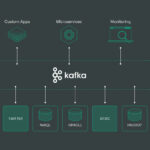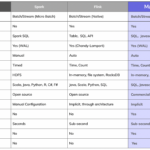Self-Organizing Maps (SOM) have emerged as a powerful tool in the realm of large-scale data clustering, particularly within the context of Big Data analytics. SOM is a type of artificial neural network that is capable of organizing high-dimensional data into a low-dimensional map, effectively capturing complex patterns and relationships within datasets of massive sizes. By leveraging SOM for clustering tasks, organizations can uncover valuable insights, detect hidden patterns, and enhance their decision-making processes in the era of Big Data. This article explores the pivotal role of Self-Organizing Maps in large-scale data clustering within the realm of Big Data analytics.
In the realm of Big Data, effective data analysis is paramount to drive insights and decision-making. One of the innovative techniques that have gained prominence in this domain is the use of Self-Organizing Maps (SOMs). These are a type of unsupervised learning algorithm that provide a means of visualizing and interpreting high-dimensional data through the process of clustering.
Understanding Self-Organizing Maps
Self-Organizing Maps are a form of artificial neural networks that are primarily used for clustering and data visualization. Introduced by Bartosz Kohonen in the 1980s, SOMs are designed to help reveal hidden patterns in data while preserving the topological properties of the input space. They work by mapping high-dimensional input data into a lower-dimensional space, typically two-dimensional, making it easier to explore and understand complex datasets.
The Mechanism of Self-Organizing Maps
The operational framework of SOMs involves several key steps:
- Initialization: The SOM is initialized with random weights assigned to the neurons, which correspond to the input data dimensions.
- Competition: For each input vector, the network identifies the Best Matching Unit (BMU)—the neuron whose weight vector is closest to the input vector.
- Cooperation: Neighbors of the BMU are also updated based on their distance from the BMU, creating a neighborhood effect.
- Weight Update: The weight of the BMU and its neighbors are adjusted to be more like the input vector, gradually training the map.
- Iteration: This process is repeated with multiple input data points over several epochs until the weights stabilize.
Advantages of Using Self-Organizing Maps
Self-Organizing Maps provide several benefits when it comes to clustering large-scale data:
- Dimensionality Reduction: SOMs effectively reduce the dimensionality of data without losing significant information, which is crucial in the context of Big Data.
- Topological Representation: They preserve the topological structure, allowing for similar data points to cluster together based on their input features.
- Visualization: SOMs enable the visualization of complex data, allowing data scientists to interpret clusters and trends intuitively.
- Unsupervised Learning: As an unsupervised learning technique, SOMs do not require labeled data, making them adaptable to various domains.
Applications of Self-Organizing Maps in Big Data Clustering
Self-Organizing Maps find extensive applications across diverse sectors, enhancing the ability to process and analyze large datasets:
1. Market Segmentation
In the marketing realm, businesses utilize SOMs to analyze consumer behavior, identifying distinct market segments based on purchasing patterns and preferences. By clustering similar customer profiles, companies can tailor marketing strategies effectively.
2. Image and Video Processing
SOMs are utilized in computer vision to cluster images based on their characteristics, aiding in tasks such as image retrieval, recognition, and segmentation. This helps to manage large volumes of visual data efficiently.
3. Bioinformatics
In the field of bioinformatics, SOMs are employed to cluster gene expressions, enabling researchers to find patterns in genomic data. This facilitates better understanding of genetic relationships and disease correlations.
4. Network Security
Self-Organizing Maps can enhance cybersecurity by clustering network traffic data to classify normal and abnormal behavior. This allows for the early detection of potential threats or intrusions in large enterprise networks.
5. Financial Analytics
In finance, SOMs help in clustering stock market trends and patterns, enabling analysts to identify correlations between stocks and suggest investment strategies based on analyzed datasets.
Challenges in Implementing Self-Organizing Maps
Despite their advantages, the implementation of SOMs in large-scale data clustering comes with its own set of challenges:
- Computational Complexity: As the dataset grows in size and dimensions, the computational demand for training SOMs increases significantly, which can hinder performance if not optimized properly.
- Parameter Sensitivity: The performance of SOMs can vary depending on parameters such as learning rate, neighborhood size, and initialization methods, making it crucial to carefully tune these parameters.
- Interpretability: Although SOMs provide visual clustering, interpreting the significance of resulting clusters can be complex, requiring additional analytical methods.
Future Directions for Self-Organizing Maps in Big Data
The landscape of Big Data is constantly evolving, and Self-Organizing Maps are expected to advance in several ways:
1. Integration with Other Machine Learning Techniques
Combining SOMs with other machine learning techniques, such as Deep Learning or Reinforcement Learning, could enhance their classification abilities and increase robustness in handling diverse data types.
2. Scalability Enhancements
Research focused on enhancing the scalability of SOM algorithms will be critical for their application in massive datasets. Techniques like parallel processing and distributed computing could be vital pursuits in this area.
3. Enhanced Visualization Techniques
Further developments in visualization techniques will allow for better interpretation of SOM outputs, thereby enriching the user experience and accessibility of data science insights.
4. Application in Real-Time Analytics
As organizations increasingly emphasize real-time data analysis, adapting SOMs for applications in real-time clustering and data analysis will be an important research direction.
Conclusion
Self-Organizing Maps represent a powerful tool in the arsenal of techniques for clustering large-scale data amidst the complexities of Big Data. Their unique ability to visualize and interpret high-dimensional data in a topologically preserved manner offers invaluable insights, fostering better decision-making across industries. As research and technology continue to evolve, the integration and application of SOMs are poised to expand, unlocking further potential within the realm of Big Data.
Self-Organizing Maps offer a powerful and efficient solution for clustering large-scale data in the realm of Big Data. Their ability to capture complex patterns and reduce dimensionality makes them a valuable tool for uncovering insights and trends within massive datasets. By allowing for unsupervised learning and visualization of clusters, Self-Organizing Maps play a crucial role in facilitating data analysis and decision-making processes in the era of Big Data.














